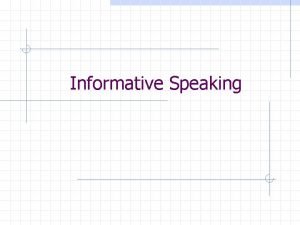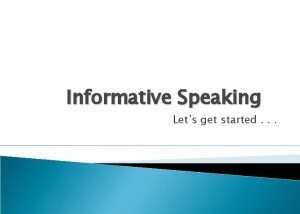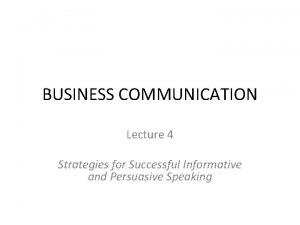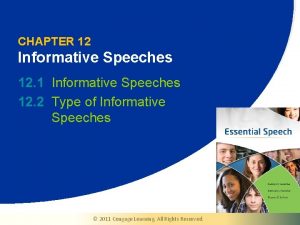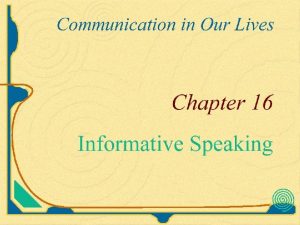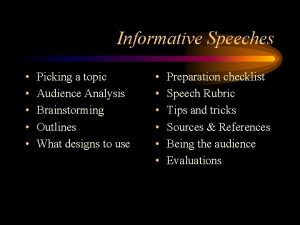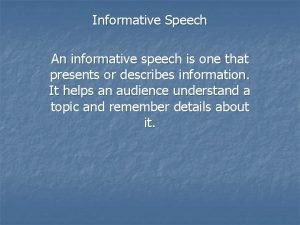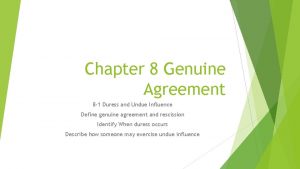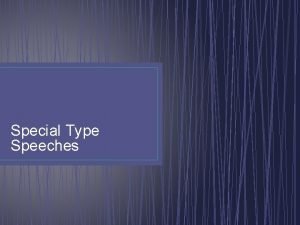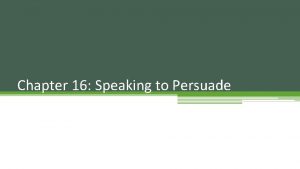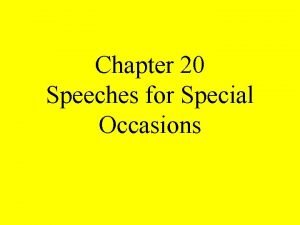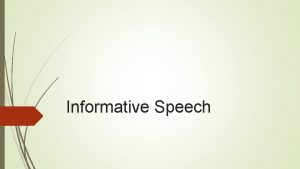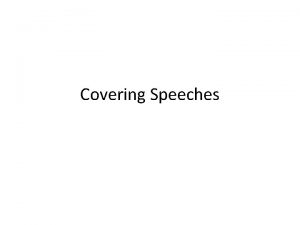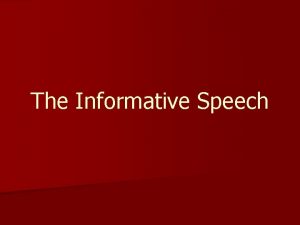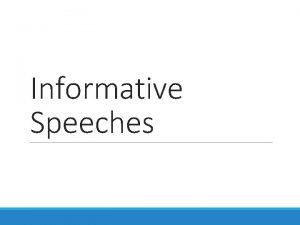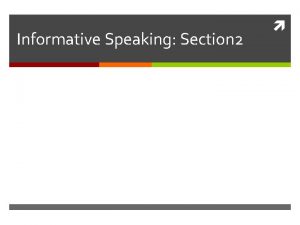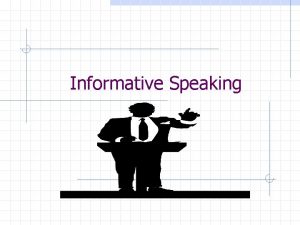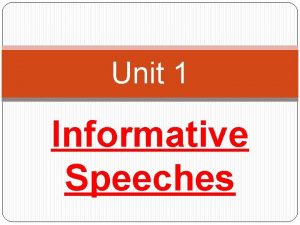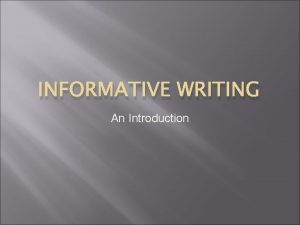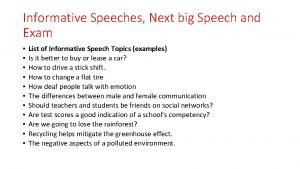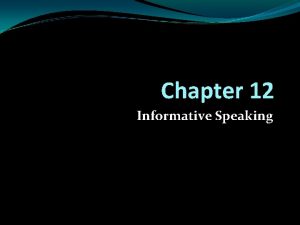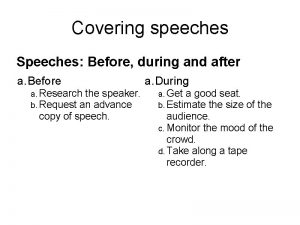Informative Speeches Informative Speech is Due May 7






























- Slides: 30

Informative Speeches Informative Speech is Due May 7

Homework Read Chapters 12 & 16 Rewrite your Preparation Outline (make corrections) it is Due next class. Write your Speaking Outline (don’t forget cues) Make sure your Speech is under 4: 15; after 4: 15 you start loosing points. (3: 45 -4: 15 is safe)

The Art of Public Speaking Instructor: Jered Faires Week #8

Chapter 8 Beginning and Ending the Speech

introduction 1. Gain interest and Attention 1. Use a HOOK to relate to the audience 2. State the importance of your topic 3. Startle the audience 4. Arouse the Curiosity of the audience 5. Question the audience 6. Use a Quotation 7. Tell a Story (“Who is my neighbor? ”)

introduction 2. Create a positive relationship See the example of Reagan p. 108 3. Establish Credibility 4. Preview the body of the speech using a preview statement See checklist for speech introduction p. 110 See Tips for Introduction p. 111

2 nd look at a good introduction (8. 1 – 8. 2) In your notebook/on paper record how the speaker: 1. Gains Interest 2. Reveals Topic 3. Establishes Credibility 4. Previews the Body

Homework – How good is your introduction? In pairs, switch papers with your desk mate 1. You will be given 10 minutes 2. Read their introduction 3. Compare with checklist on p. 110 4. Give your partner feedback 5. Partner makes any changes

Conclusion Main idea 1. Lets the audience know your are ending 2. Reinforces the central idea

conclusion Signal the end of the speech 1. Crescendo ending (reaches the climax) 2. Dissolve ending (slowly drifts off)

2 nd look at a good conclusion (8. 4 – 8. 5) In your notebook record how the speaker 1. Lets the audience know he is ending 2. Reinforces central idea

Conclusion Reinforce the Central Idea 1. Summarize the speech 2. End with a Quotation 3. Make a dramatic statement 4. Refer back to the introduction 5. See Checklist and Tips on p. 116

Homework – How good is your conclusion? In pairs, switch papers with your desk mate 1. You will be given 10 minutes 2. Read their Conclusion 3. Compare with checklist on p. 116 4. Give your partner feedback 5. Partner makes any changes

Chapter 9 Outlining the Speech

Two types of outlines Preparation Outline Detailed outline developed while you are working on your speech using complete sentences. Speaking Outline Simplified version of preparation outline using only key words or phrases to help you remember major points, subpoints and connectives. (use to give speech – not required for the first speech!)

Preparation Outline Helps you prepare the speech. Should be a fully developed speech manuscript written in outline form. (very detailed). Includes the following. Title Specific purpose- what you want to accomplish Central idea- your main focus Introduction Main points Sub points Connectives Conclusion bibliography

Preparatory Outline Use full sentences. Label the parts of your speech (Intro, body, conclusion, etc).

Organizing Your Preparation Outline Title Specific Purpose Statement Central idea (one sentence statement that sums up the major ideas of your speech) Introduction Get audience attention Tell audience what your speech is about Body: Two to three main points Use connective transition statements Conclusion: Bring the speech to a thought-provoking end Summarize thesis of your speech

Chapter 9 In Class Focus Using a consistent pattern of symbolization and indentations. Main points are usually identified by Roman numerals Subpoints are identified by capital letters Sub-subpoints are identified by numbers Main points, subpoints and sub-subpoints are all indented equally and aligned down the page I. Main Point A. Subpoint B. Subpoint 1. Sub-subpoint 2. Sub-subpoint a. Sub-subpoint b. Sub-subpoint II. Main Point A. Subpoint 1. Sub-subpoint 2. Sub-subpoint B. Subpoint 1. Sub-subpoint 2. Sub-subpoint

Speaking Outline

The Speaking Outline-follows same format as preparation outline I. Only contains key words or phrases II. Purpose – memory jogger III. Statistics, quotations, and cues (smile, pause, louder, repeat, etc. )

The Speaking Outline I. Follows the visual framework of the preparation outline II. Legible and brief III. Use highlighting, underlining, etc. to emphasize points. IV. You will use the speaking outline to give your second speech!

“Outline Maker” on Textbook CD-ROM under Applications/speech_outliner

Giving your speech a title I. Your title should be: A. Brief B. Gain attention quickly C. Contain the main thrust II. Three types of titles (p. 121122) • A. Straightforward and descriptive: “Living with deafness” • B. Figurative: “The Sounds of Silence” • C. Question: “Can you see what I'm saying? ”

Bibliography Printed Source • • Author’s name Title of publication Date of publication Place of publication Publishing company Volume number The page numbers Web Site • • • Authors and editor names Title of the page The company or organization who posted the webpage The web address The last date you looked at the page

Format – use APA format • Books & magazines • Authors last name, first name. Book title. City of publication: Publishing company, publication date. • Allen, Thomas B. Vanishing Wildlife on North America. Washington, D. C. : National Geographic Society, 1974. • Website or Webpage • Author’s last name, first name. “Title of work within a project or database. ” Title of site, project or database. Editor. Electronic publication information. Date of access • Levy, Steven. “Great Minds, Great Ideas. ” Newsweek 27 May 2002. htt: //www. msnbc. com/news 754336. asp 10 June 2002

“Bibliography maker” on Textbook CD-ROM under Applications/APA bibliomaker

Summary Outlines are essential to effective speeches. Outlines makes sure related ideas are together. Speech is coherent Two types: Preparation and Speaking. Must turn in a copy of your Preparation outline the day you give your speech!

Visual Framework Summary I. Introduction A. Give your thesis statement B. Introduce main points of the speech II. Body A. Point 1 1. Sub-point 1 2. Sub-point 2, etc. B. Point 2 1. Sub-point 1 2. Sub-point 2, etc. C. Point 3, etc. III. Conclusion/Summary A. Restate your thesis statement in summary form B. Give the audience something to think about

Homework: 1. Prepare your Speaking Outline for your Informative Speech - to be turned in before your speech (make 2 copies) – worth 10% of your speech grade. 2. Practice your Informative Speech
 Informative vs persuasive speech
Informative vs persuasive speech Informative speech vs persuasive speech
Informative speech vs persuasive speech Quadrilatero senza lati paralleli
Quadrilatero senza lati paralleli Liberty chapter 20
Liberty chapter 20 Due're/due opposti
Due're/due opposti Due piccole sfere identiche sono sospese
Due piccole sfere identiche sono sospese Informative or expository speech
Informative or expository speech Informative vs persuasive speech
Informative vs persuasive speech Informative speech
Informative speech Informative speech strategies
Informative speech strategies Persuasive
Persuasive Informative speech communication strategies
Informative speech communication strategies Includes anything visible and tangible in form
Includes anything visible and tangible in form Persuasive speech on tattoos
Persuasive speech on tattoos Informative speech characteristics
Informative speech characteristics Specific purpose statement for an informative speech
Specific purpose statement for an informative speech Audience analysis example for informative speech
Audience analysis example for informative speech Informative speech about phobias
Informative speech about phobias How to start informative speech
How to start informative speech Duress occurs when
Duress occurs when Physical incompatibility with example
Physical incompatibility with example Twelfth night speeches
Twelfth night speeches Entertaining speeches
Entertaining speeches Ethos examples
Ethos examples Speeches on questions of value are usually organized
Speeches on questions of value are usually organized Famous speeches with ethos pathos and logos
Famous speeches with ethos pathos and logos Short example of an expository speech
Short example of an expository speech There are how many types of courtesy speech?
There are how many types of courtesy speech? Demonstrative speech topics
Demonstrative speech topics Constructive speeches
Constructive speeches The outsiders literary analysis essay
The outsiders literary analysis essay
